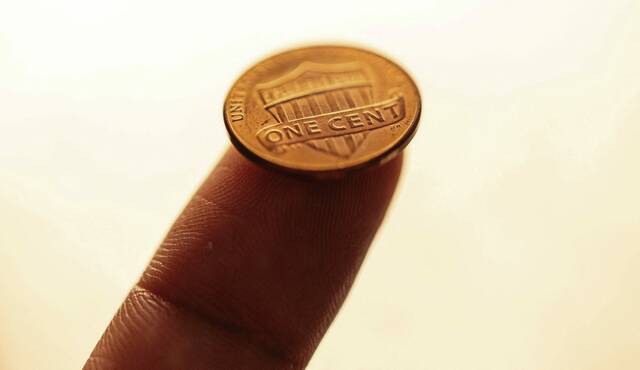https://triblive.com/news/world/u-s-treasurer-bessent-to-strike-final-penny-at-philadelphia-mint/
The penny, America's oldest and most iconic coin in circulation, dies at 232

The penny, the United States’ iconic one-cent coin whose copper face and everyman symbolism endeared it to millions of Americans before it fell into change-drawer obscurity, died on Nov. 12, 2025. It was 232 years old.
In its heyday it was ubiquitous, an American avatar of grit, humility and thrift. Jauntily jingling in pockets and purses, it proudly rubbed shoulders with its currency contemporaries, springing for gumballs or the occasional grocery item.
But in the end, plagued by doubts about self-worth, it would finally fade from the spotlight, like a screen star of decades past whose phone had stopped ringing long ago.
Decades of inflation had taken their toll on the humble coin. It took its final breath in Philadelphia, where it had been born in 1793, a year after its authorization by the newly established U.S. Mint: On Wednesday afternoon, the mint there formally stamped what it said would be the country’s last circulating pennies in a ceremony celebrating an icon as emblematic of the national ethos as lunch pails, piggy banks and the American Dream.
“The penny is an iconic American coin,” said Gabriel Mathy, a professor of economics at American University. “It’s the end of an era.”
In its prime, the penny wielded outsized influence: Tossed into fountains, it could answer unrealized wishes. A penny saved was a penny earned; it was pinched, pressed into loafers and placed on graves as a way of honoring the dead. Offered for one’s thoughts, it could elicit two cents, doubling its return.
Caroline Turco, assistant curator of the American Numismatic Association’s Money Museum in Colorado Springs, Colorado, said that whenever she spies a penny on the street, she still thinks of the rhyme, “Find a penny, pick it up, all day long you’ll have good luck.”
So mighty was the penny’s sway that legions of sales pitches would rely on marketing psychology built upon its mere absence. Why shell out 10 dollars when you can pay $9.99?
The penny had remade itself multiple times over the years, succeeding a one-cent predecessor authorized by the Continental Congress in 1787 and designed by Benjamin Franklin until the mint’s creation in 1792. Made of pure copper, it featured a woman with flowing hair, symbolizing liberty.
Its name reflected the country’s colonial roots, a derivation of the British word “pence,” which the American founding fathers disposed of along with the English monarchy.
In 1857, the penny assumed a more modest size, incorporating 12% nickel and a flying eagle design on its face; two years later, that design would be replaced by the image of liberty wearing an eagle-feathered headdress.
The face of the penny as we know it today, featuring the head of Abraham Lincoln, was first minted in 1909. A pair of wheat sheaves originally graced its tails side before being changed to depict the Lincoln Memorial 50 years later.
But even to those beyond its close quarters, it was becoming obvious that things for the penny had changed. Its spending power diminished; it could barely afford a stick of bubble gum, making it as destitute as the Great Depression panhandlers who searched for it on lamp-lit street corners.
Eventually, hints of its demise began to show. By 1982, the penny’s once-copper character had given way to cheaper zinc as metal prices climbed and its popularity with the public began to wane. In 1990, politicians began to suggest that perhaps the penny’s time was, in a word, spent; it was simply too costly to make.
In other words, it wasn’t even worth itself.
“Rising metal prices doomed the penny,” Mathy said. “This meant it would eventually be phased out.”
Before long, some reported spotting the penny wallowing in dark corners of desk drawers and glove compartments, relegated to canning jars or coffee containers or discarded for the taking on convenience store counters. Unused, unwanted, hiding under sofa cushions: This had become the penny’s sad existence.
Even as the penny underwent a final redesign in 2010, its tails side replaced with the Union Shield, the whole affair had the sentimental sheen of a farewell tour. Ultimately, the inflationary trends that had long nagged at the penny’s wellbeing became too weighty to bear.
The U.S. Mint’s fiscal year 2024 report said the one-cent coin cost 3.7 cents to produce, a 20% jump from the year before. Beyond that, Americans now use less cash overall, favoring digital payments and credit cards.
The penny, the U.S. Treasury recently declared, “is no longer necessary to meet the needs of the United States.”
In February 2025, President Donald Trump ordered the department to terminate production of the penny, and in May the mint ordered its final set of penny blanks. With Wednesday’s proceedings, the penny joined the expired ranks of former U.S. denominations such as the half-cent (d. 1857) and the three-cent trime (1873.).
Turco, of the numismatic association’s museum, said the penny should be remembered “as a staple of our economy that no longer really functions in the economy. That doesn’t mean it wasn’t an important piece. It’s been incredibly impactful in our culture.”
The penny is survived by the nickel, the dime and the quarter.
Copyright ©2025— Trib Total Media, LLC (TribLIVE.com)
